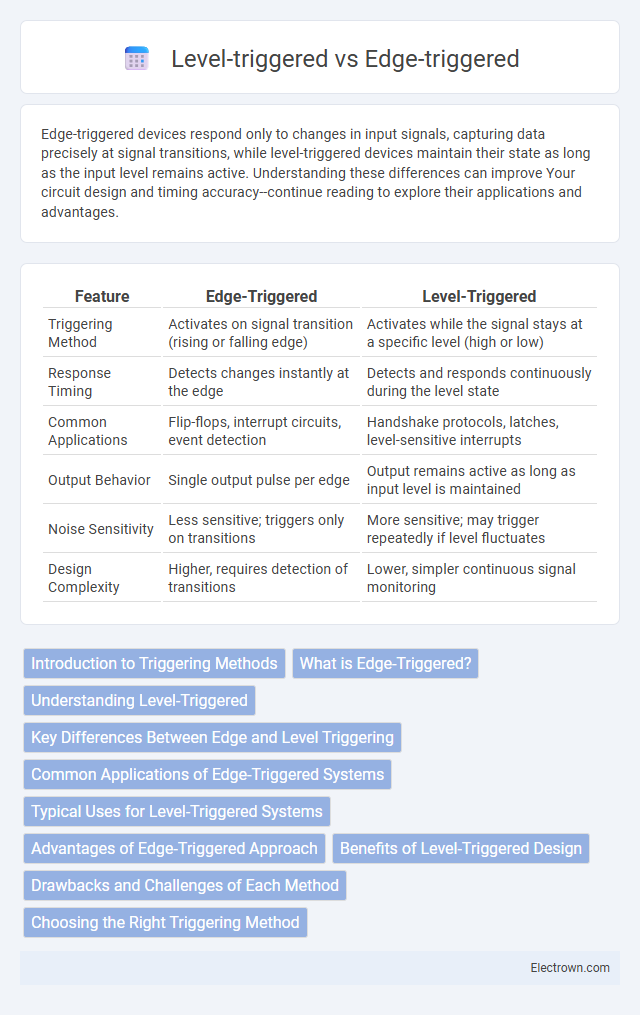Edge-triggered devices respond only to changes in input signals, capturing data precisely at signal transitions, while level-triggered devices maintain their state as long as the input level remains active. Understanding these differences can improve Your circuit design and timing accuracy--continue reading to explore their applications and advantages.
Table of Comparison
| Feature | Edge-Triggered | Level-Triggered |
|---|---|---|
| Triggering Method | Activates on signal transition (rising or falling edge) | Activates while the signal stays at a specific level (high or low) |
| Response Timing | Detects changes instantly at the edge | Detects and responds continuously during the level state |
| Common Applications | Flip-flops, interrupt circuits, event detection | Handshake protocols, latches, level-sensitive interrupts |
| Output Behavior | Single output pulse per edge | Output remains active as long as input level is maintained |
| Noise Sensitivity | Less sensitive; triggers only on transitions | More sensitive; may trigger repeatedly if level fluctuates |
| Design Complexity | Higher, requires detection of transitions | Lower, simpler continuous signal monitoring |
Introduction to Triggering Methods
Edge-triggered and level-triggered methods represent two fundamental approaches to triggering events in digital circuits and systems. Edge-triggered triggering responds to changes or transitions, such as a rising or falling edge of a clock signal, making it ideal for capturing precise data changes at specific moments. Level-triggered triggering, in contrast, is activated when the input signal maintains a particular level or state, providing continuous control during the active period and influencing how your system processes input signals.
What is Edge-Triggered?
Edge-triggered refers to a type of digital circuit behavior where the output changes state only at the moment of a specific signal transition, typically a rising or falling edge of a clock pulse. This mechanism ensures that data is captured precisely at the triggering edge, reducing the risk of glitches or unstable outputs caused by signal levels held over time. You benefit from edge-triggered designs in synchronous systems requiring precise timing and coordinated data transfers.
Understanding Level-Triggered
Level-triggered circuits respond to the duration of the input signal being at a specific logic level, maintaining output as long as the input level is stable and active. This characteristic allows continuous monitoring and responsiveness to the input signal's steady state, making it suitable for asynchronous inputs or when signal duration is critical. Unlike edge-triggered circuits that react to transitions, level-triggered devices prioritize input signal persistence, enabling consistent output during the active level period.
Key Differences Between Edge and Level Triggering
Edge-triggered systems respond to input signals only at the moment of a transition, capturing data on rising or falling edges, while level-triggered systems remain sensitive as long as the input maintains a specific level. Edge triggering reduces the risk of glitches by sampling inputs precisely at change points, ensuring faster and more reliable data processing in sequential circuits. Your choice between edge and level triggering influences timing accuracy and circuit behavior, especially in flip-flops and memory devices.
Common Applications of Edge-Triggered Systems
Edge-triggered systems are widely used in digital circuits for detecting precise timing events, such as clock edges in microprocessors and flip-flops. These systems excel in applications requiring synchronization, including data transfer in communication protocols like SPI and I2C. Their ability to respond quickly to changes on signal transitions makes them ideal for event-driven designs and interrupt handling in embedded systems.
Typical Uses for Level-Triggered Systems
Level-triggered systems are commonly used in applications where continuous signal monitoring is essential, such as memory device interfaces and communication protocols. These systems maintain a stable state as long as the input level remains constant, making them ideal for detecting and holding data signals in registers or latches. Their simplicity and reliability suit designs requiring sustained data storage and synchronization without frequent signal transitions.
Advantages of Edge-Triggered Approach
The edge-triggered approach offers superior noise immunity by activating only at signal transitions, reducing false triggers common in level-triggered systems. This method ensures faster response times and more precise synchronization in digital circuits, enhancing overall system reliability. Your designs benefit from lower power consumption and minimized timing errors, making edge-triggered triggers ideal for high-speed applications.
Benefits of Level-Triggered Design
Level-triggered design provides stable and continuous signal monitoring, enhancing data integrity by capturing signals as long as they remain active. It reduces the risk of missing transient events compared to edge-triggered designs, making it ideal for applications requiring reliable state detection. Your system benefits from simplified timing analysis and easier synchronization due to consistent signal behavior throughout the active level.
Drawbacks and Challenges of Each Method
Edge-triggered mechanisms often face challenges such as susceptibility to glitches caused by noise or signal bounce, which can lead to missed or false triggers in high-frequency circuits. Level-triggered systems may suffer from difficulties in handling prolonged activation signals, resulting in potential data instability or race conditions during the level-sensitive period. Implementing reliable synchronization and timing control requires careful design consideration to mitigate these drawbacks in both edge-triggered and level-triggered approaches.
Choosing the Right Triggering Method
Choosing between edge-triggered and level-triggered methods depends on the timing requirements and system responsiveness. Edge-triggered triggers actions on signal transitions, ideal for detecting changes and minimizing processing overhead in high-speed systems. Level-triggered methods maintain the triggered state as long as the signal level is active, providing stability for continuous monitoring and control applications.
Edge-triggered vs level-triggered Infographic

 electrown.com
electrown.com